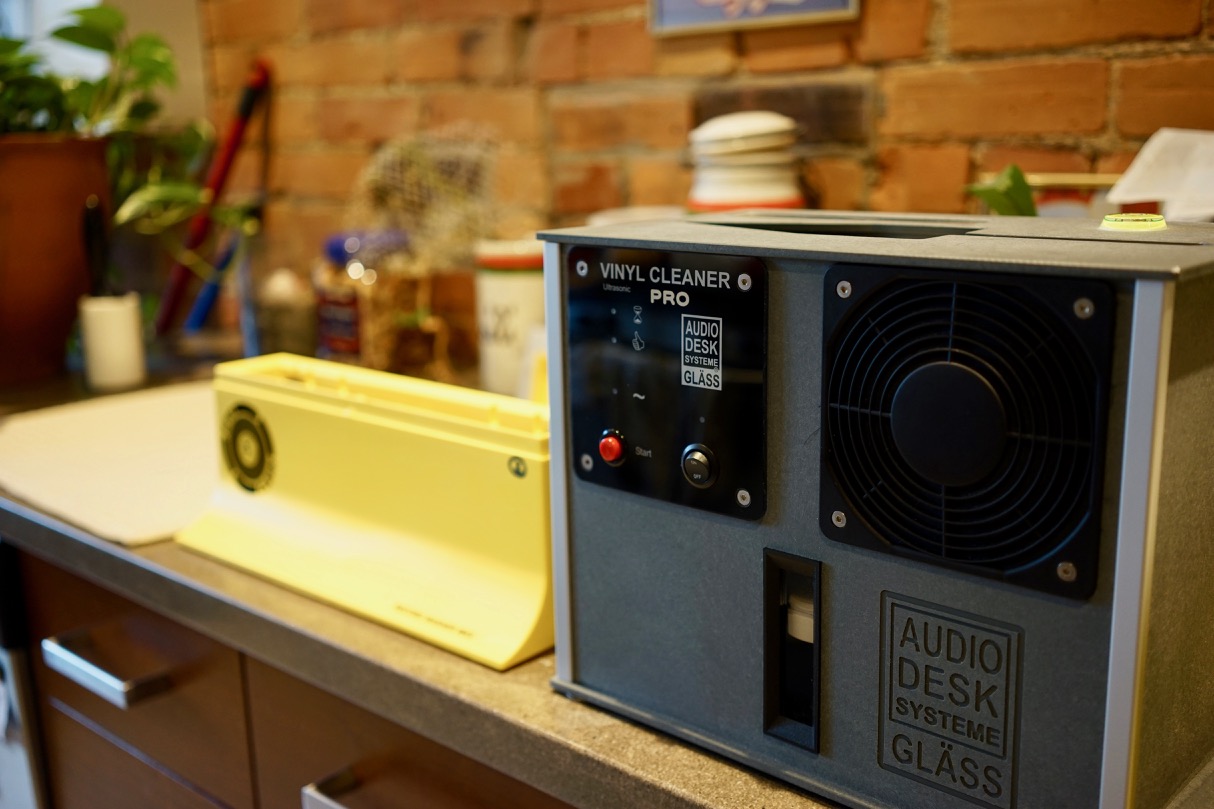Washing Records with the Audio Desk Vinyl Cleaner Pro Ultrasonic and the Spin Clean
In getting fully re-obsessed with (and re-committed to) vinyl in the last year, I knew I was putting myself on course for a collision for one of my least favourite things: washing records.
Back in my last phase of vinyl obsession, in my mid-twenties (mid-aughts), I had a traumatic experience with vacuum cleaning. I bought a “KAB EV-1,” which promoted itself (and still does) as a Nitty Gritty system to which you attach your own vacuum cleaner, thus saving most of the cost. As the proud owner of a very respectable Electrolux vacuum (still going strong!), I was very happy to save myself some money. As I was on a very, very restricted budget at that time, it was indeed the only system I could afford.
Alas, it was a disaster. I cleaned two records on it, and they both came out sounding way, way worse than they did going in. I figured Roy Gandy of Rega must be right; he famously said that the best way to clean a record is to run a tiny diamond stylus over it, i.e., play a record! I never cleaned another record.
Wading back into vinyl, I asked my record junkie friend Jared what he used. He said he used a yellow plastic thing called a Spin Clean, which cost all of $100 CDN. I read a bunch of reviews and — though maybe lusting just a bit after expensive Loricrafts and the like — figured that was the way to go.
Developing my Double Spin Clean system
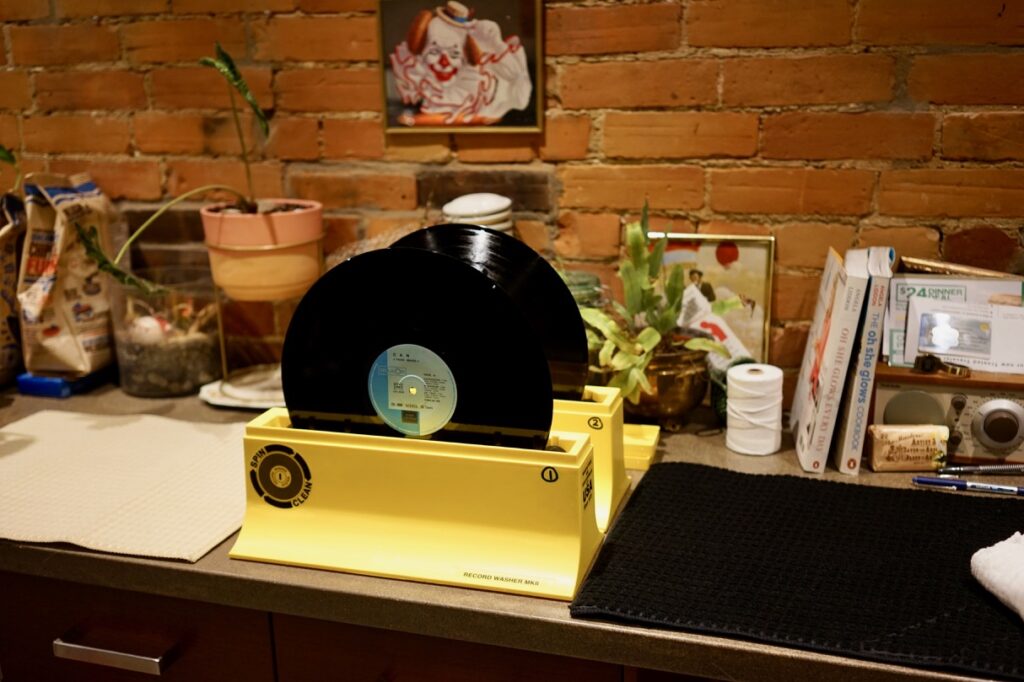
I was pretty terrified washing my first record on the Spin Clean. I probably pulled out one of my mom’s old destroyed records to test it out on — a scratched-to-hell Crosby, Stills, Nash, and Young record, I think. Anyway, it seemed to pass the first test: it didn’t make things sounds any worse. Eventually I worked my way up to records I actually wanted to clean. Then I washed my most precious records. They, too, sounded no worse coming out of the Spin Clean. Indeed, yes, a bunch of them sounded better — especially, obviously, the dirty ones.
There were a few really transformational cleanings. My dad’s first Canadian pressing of Dark Side of the Moon was dirty but totally scratch-free: it was brought back to life and sounds astoundingly good. But usually — ironically, but totally in keeping with my experience with the dreaded KAB — the records that sounded best after washings were ones that hadpreviously been washed on vacuum cleaners and were full of gunk and covered in soapy residue. The disc that improved the most was a Japanese pressing of A Love Supreme that I picked up at Academy in NYC. It looked absolutely mint but had horrible surface noise. I noticed some soapy film in the dead wax and thought it might benefit from a wash. Sure enough, after a few washings it sounded pretty much perfect.
This all got me thinking about soapy residue, obviously. I couldn’t see any soapy residue left over from the Spin Clean’s own washing cycle — perhaps because part of the system involves manually drying records with cloths, which I leaves less soapy water on the disc to evaporate away and leave its crud behind. But I wondered what would happen if I added a second Spin Clean to the system, which would purely serve the purpose of rinsing any remaining soap off the disc.
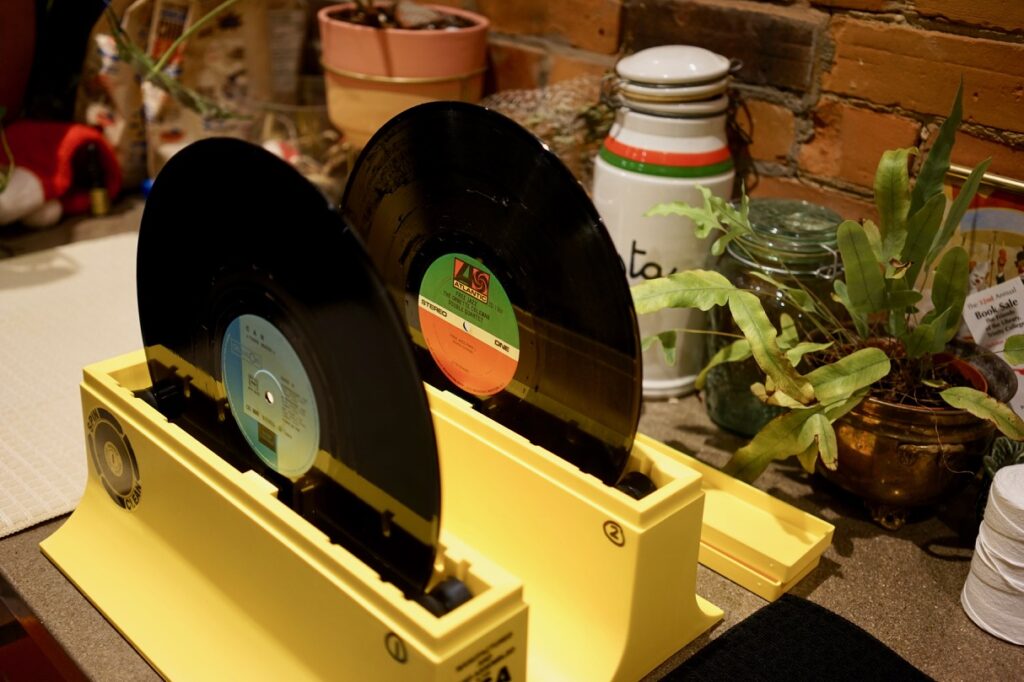
That’s the “Double Spin Clean” system up there. SC#1 is for soap washing. I would spin it three times to the right, three times to the left, let it drip for a bit, and then dry it off with one set of rags clearly marked “soap rags.” Then I’d popped the pretty-much-dry disc into SC#2, filled only with distilled water, and go through the whole procedure with a different drying mat and different rags labelled “distilled.” I’m not sure I noticed a huge difference — but it made sense and I was happy to do it. Discs always came out looking absolutely shiny and residue-free.
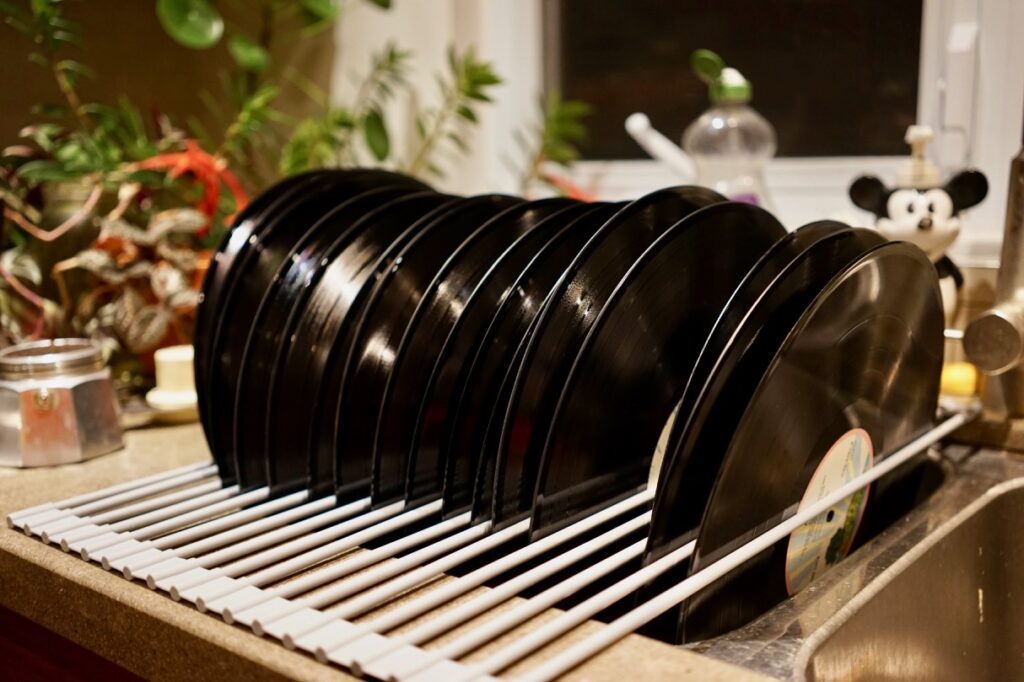
I’d then dry the discs in my sink, using one of these little sink-top drying racks, which can hold about 15 discs at a time in my sink. I’d let them sit for about 30 minutes, after which point I was confident they were totally dry. Then I’d stick them into new Mobile Fidelity inner sleeves.
The whole thing obviously took a lot of time. I kind of enjoyed it — it was somewhat therapeutic and quite relaxing. But yeah, it was time-consuming. I’d get through about 25 or 30 discs in two or three hours. One thing about the Spin Clean — and most cleaning systems, in fact — is that you can’t do anything else while you’re cleaning: you’re just standing there manually cleaning discs. And you’re on your feet, so it’s a wee bit tiring. So I would need to find a really big block of time to get any cleaning done.
Getting started with the Audio Desk
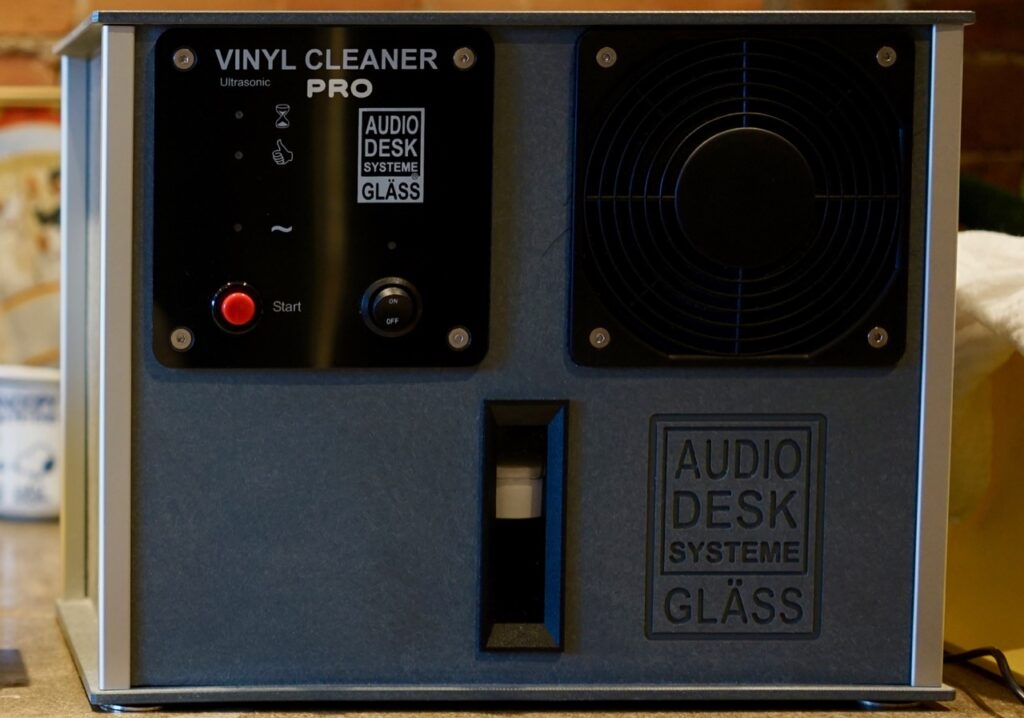
I was perfectly happy with my cheap, effective, hyperbolically rigorous, but somewhat time-consuming Double Spin Clean system — until I read this review of the Audio Desk ultrasonic cleaner by my favourite record-collecting blogger, London Jazz Collector. Here was a system that promised (a) an easier-to-use, all-in-one system that would do everything automatically while I worked or read (while sitting!), and, most temptingly, (b) better sound quality!
Ultrasonic cleaning made a lot of sense to me: using the best cleaning technology to get right into the grooves and clean out all the buried gunk that regular cleaning couldn’t touch. I had just been to see the Safdie brothers movie Uncut Gems, which — being set in the jewelry world — happened to feature an ultrasonic cleaner. I imagined myself as the hi-fi equivalent of Adam Sandler’s Howard Ratner: “Throw these in the ultrasonic… Now!”
The problem, obviously, is that the Audio Desk is ungodly expensive. My double Spin Clean system costs considerably less than the tax on an Audio Desk. Also, it’s somewhat notorious for breaking down, for leaving droplets of water on the disc after its drying cycle, for generally pissing off the people who have dropped a couple months’ salary on it.
But hey, it couldn’t hurt to look on Canuck Audio Mart and see if someone was selling one used, right? Hmm, and who could resist responding to a dealer ad for a demo model with a full warranty, maybe making a semi-lowball offer? And you’d have to be an idiot not to buy an Audio Desk, with only 120 discs under its belt and all new accessories, for less than half the new cost?
You would, I’d say. I bought one.
I got it home exactly one week ago. In the last week, I’ve cleaned about 50 discs. I’ve experienced some of the frustrations. My discs kept coming out with little droplets of water on them (this seems to have gotten a little better for some reason, but it’s still a common thing). Some discs got enough water on the label in the cleaning process to leave marks. It’s really annoyingly loud — apparently quieter than some vacuum competitors, but a hell of a lot louder than the silent Spin Clean. The beeps it emits are also insanely loud and annoying (see the video below for both the sights and sounds of the Audio Desk). My partner has not been happy with me this week. I’ve had a headache since the day I bought it. (As I write this, I’m washing discs — with headphones on.)
Also, it didn’t significantly reduce surface noise on any disc I’d previously cleaned with the Spin Clean. There were a few exceptions to this (including the disc cleaned in the video below, which lost some of its background hiss, much like the sound of a disc pressed on recycled vinyl), but for the most part, if they had surface noise coming out of the Spin Clean, they had the same surface noise coming out of the Audio Desk.
But only one thing really mattered to me. And yes: after very extensive listening over the past week, and a million ways of comparing discs before and after cleaning, I’ve convinced myself that they really do sound better coming out of the Audio Desk. You can read all about that in my Audio Desk Listening Test.
Developing my Audio Desk + Spin Clean system
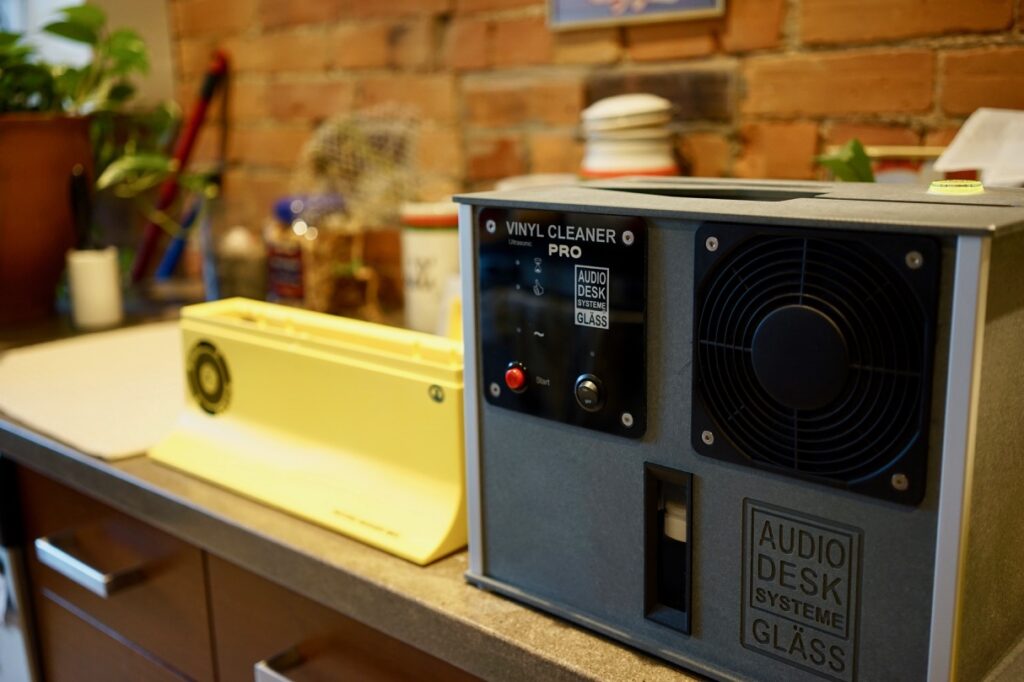
Still, one thing bugged me about the Audio Desk. You can probably guess what it is: no distilled water rinse.
Obviously a big part of the purpose of the Audio Desk is simplicity: you push a button, go do something else for six minutes, and come back to a clean, dry, better-sounding record.
In practice, that doesn’t happen every time, due to the droplet problem. (And I really hate the idea of wet discs going back into plastic sleeves: total mold breeding ground.) So if it’s a little wet anyway, why not give it a distilled water bath in the Spin Clean?
That’s what I’ve been doing. In the course of my Listening Test, I devised a couple of tests to see whether the distilled bath made a difference — and I found it did make the discs sound a little better. (I’m not the only one: this Audio Desk review by Constantine Soo also found that discs sound better after a bath.)
I figured this was because it was removing soap residue, and that may be it. But looking in the bottom of the Spin Clean after several distilled baths, I came up with another theory.
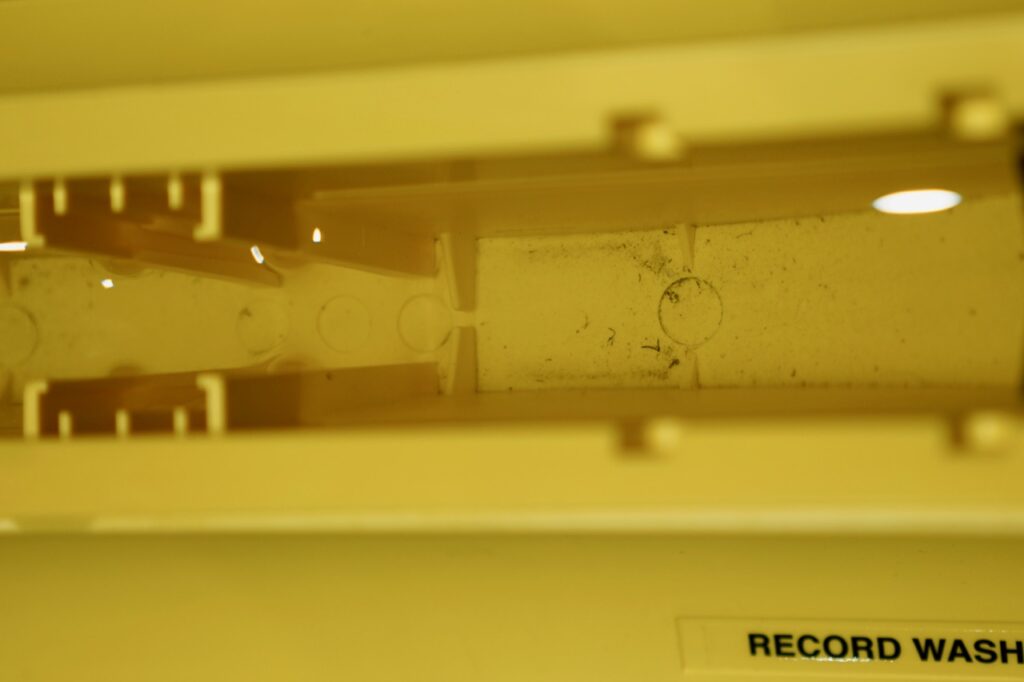
That’s after rinsing about 10 discs. There’s a lot of black stuff in there! I did a lot of distilled rinsing in my Double Spin Clean setup, and never saw this much debris in the bottom of the SC. Yes, the black stuff might just be velvet from the brushes — but, like I said, I never saw anything like that before I started rinsing discs cleaned in the Audio Desk. (Another reason I have to believe this isn’t just velvet-bits: when I wash discs using fewer cycles on the AD, less black gunk seems comes out. When I did 15 discs on 1-cycle cleanings while writing this post, there was about half as much gunk in the photo below, which was taken on a round when I was mostly doing 4 cycles.)
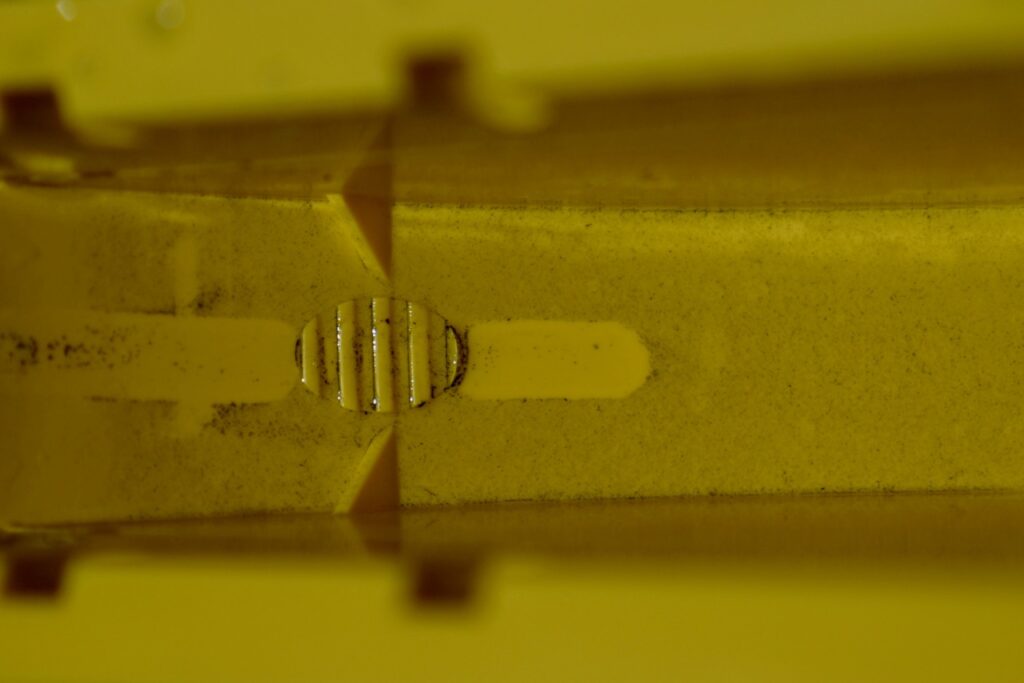
There’s another look at the bottom of the Spin Clean, this time after rinsing another set of about 15 records. I ran my finger through the residue to give you a sense of the contrast. Something is coming off of the discs post-ultrasonic cleaning, clearly. (It’s actually kind of reassuring, isn’t it? The ultrasonic cleaner is really pulling a lot of crap off of these discs! Or scary — is it eating the discs?!)
Anyway, for me, it’s worth the trouble to rinse that stuff off.
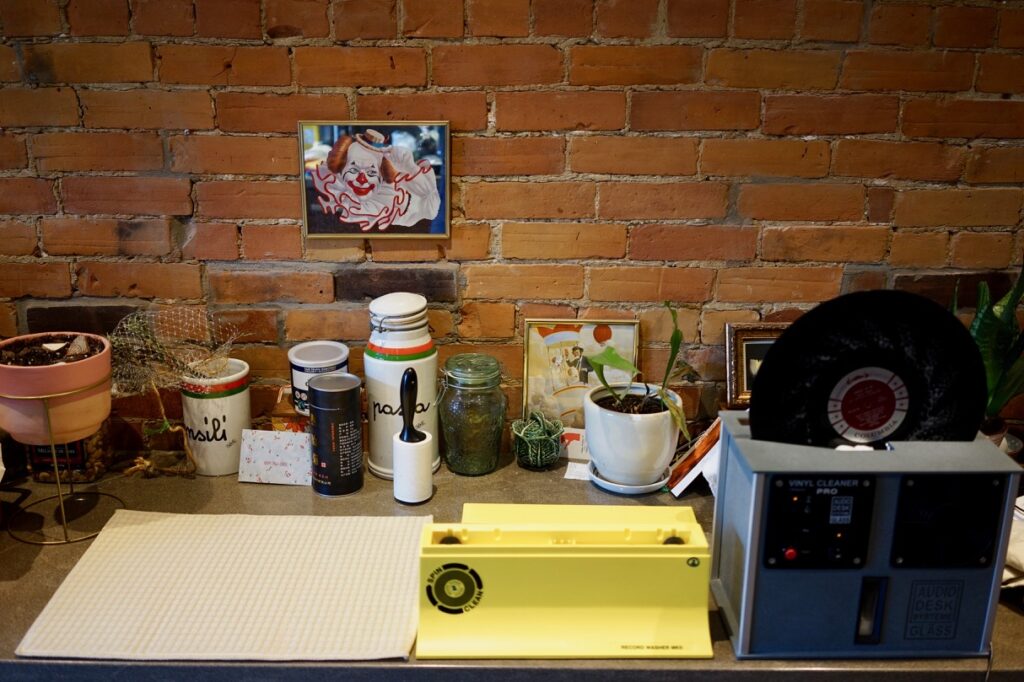
Above, you can see my basic setup for the hybrid procedure. I wash the disc in the Audio Desk. I pull the dry (or dry-ish) disc out and put it in the Spin Clean and give it three spins each way. Then I dry it by hand on the mat to the left with a Spin Clean cloth. Then I do one of two things, depending whether I’m doing a big batch.
If I’m just doing one or two discs, I throw it back in the ultrasonic (Ratner voice!) for a two-minute dry cycle (which the Audio Desk does if you hold the start button for six ear-destroying beeps). You can see (and hear!) the full procedure in this stirring 13-minute-long YouTube video, in which I subject the disc to a probably-unecessary elongated four-cycle ultrasonic cleaning (that’s why I hold the start button for four beeps at the start).
If I am doing a bigger batch, I just use my usual drying rack setup, letting the discs air dry and saving myself some time, noise, and button-holding annoyance from the Audio Desk drying cycle. This is actually a pretty speedy process. The distilled bath only takes a minute or so per disc. And call me crazy, but I prefer the wipe-and-air-dry method to anything involving vacuums or fans (could just be the KAB trauma surfacing).
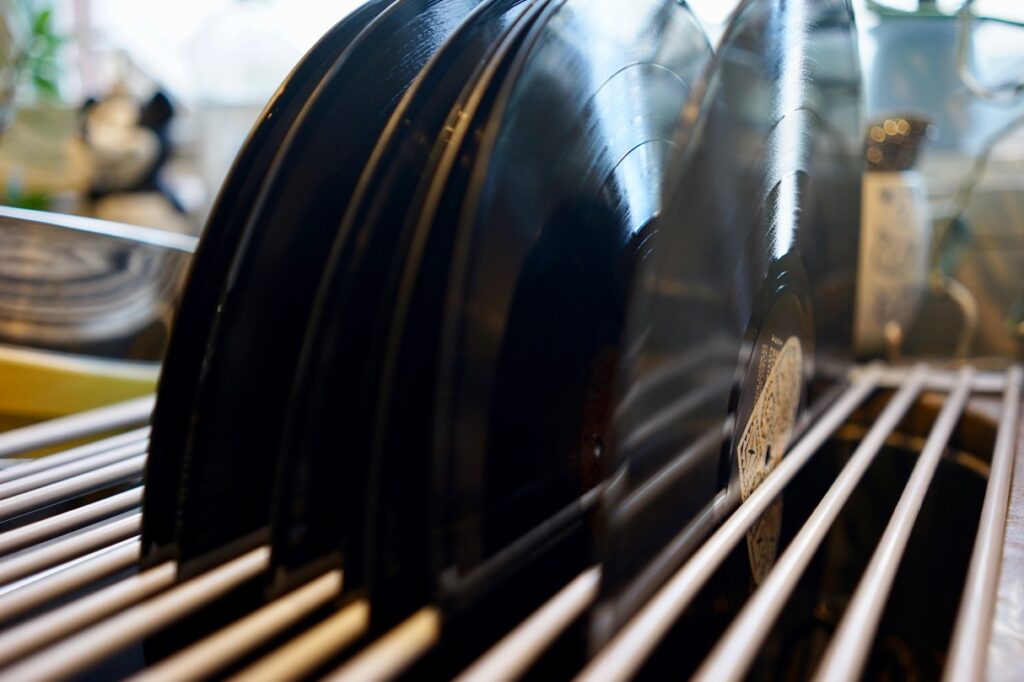
That’s how I do it. If you’re curious about why I’d go to all this trouble, you’ll need to check out the Listening Test.
One last note: a real game-changer for me with the Audio Desk is that I can do other stuff while washing records. For instance, write this blog post — which I did in about an hour a half, during which time I washed about fifteen discs.

